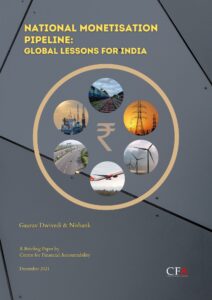 This briefing paper is focused on the recently announced National Monetisation Pipeline (NMP). The paper discusses the concepts such as asset monetisation, the Indian economic context for asset monetisation, the intense focus on infrastructure sector to continue pushing the higher economic growth rates, recent steps like the formation of a new Development Finance Institution (DFI), the National Infrastructure Pipeline (NIP) and the budgetary allocations for investments in infrastructure sector in the previous years. In the preceding months of the announcements of the NMP, the debates and discussions on public sector asset monetisation were being regularly reported in the national media showcasing asset monetisation as a viable approach for raising funds for increasing the pace of infrastructure development in India.
This briefing paper is focused on the recently announced National Monetisation Pipeline (NMP). The paper discusses the concepts such as asset monetisation, the Indian economic context for asset monetisation, the intense focus on infrastructure sector to continue pushing the higher economic growth rates, recent steps like the formation of a new Development Finance Institution (DFI), the National Infrastructure Pipeline (NIP) and the budgetary allocations for investments in infrastructure sector in the previous years. In the preceding months of the announcements of the NMP, the debates and discussions on public sector asset monetisation were being regularly reported in the national media showcasing asset monetisation as a viable approach for raising funds for increasing the pace of infrastructure development in India.
The paper provides the details of the NMP, a broad structure that it proposes to use, the classification of assets that has been given, basic differences between privatisation and monetisation, approaches to asset monetisation, total estimated value and the sectoral break-up, monetisation models and process that will be used for this pipeline as have been detailed in the NMP documents available on Niti Aayog’s website. This section intends to give a brief overview of the technicalities and processes of the NMP proposal for the common reader.
In the last section, the note makes an effort to critically analyse the previous such attempts and demonstrates the problems and concerns with the monetisation approach, which appears to be different from the outright privatisation or direct contract model. However, experiences and evidence from several countries across the world including India show that it has not been smooth sailing for such privatised projects with several of them facing problems due to social, commercial, regulatory and environmental issues. In some countries, where these programs were implemented ended up creating monopolies and oligopolies with social, economic and political implications.
In India, the privatisation and monetisation of assets have been undertaken since the post liberalisation period in piecemeal ways. Though it appears that in the previous years international institutional investors willing to invest in the country might already have national programs like NIP and NMP on their wishlist, which give a future plan in the medium term. However, the implementation of a national program is a different terrain, and it is important to understand the implications and also the readiness of the legal, regulatory and dispute resolution mechanisms to deal with this fast changing scenario.
Some of these developments and discussions around it have been widely reported in the electronic and print media in the past few months. The majority of the news reports have been arguing the need for the measures like a new DFI and asset monetisation as necessary for economic growth and fulfilling the infrastructure requirements of the country, which needs a more critical angle to analyze and weigh its pros and cons.
Read the complete briefing paper here: NMP-Global-Lessons-for-India
Centre for Financial Accountability is now on Telegram. Click here to join our Telegram channel and stay tuned to the latest updates and insights on the economy and finance.
